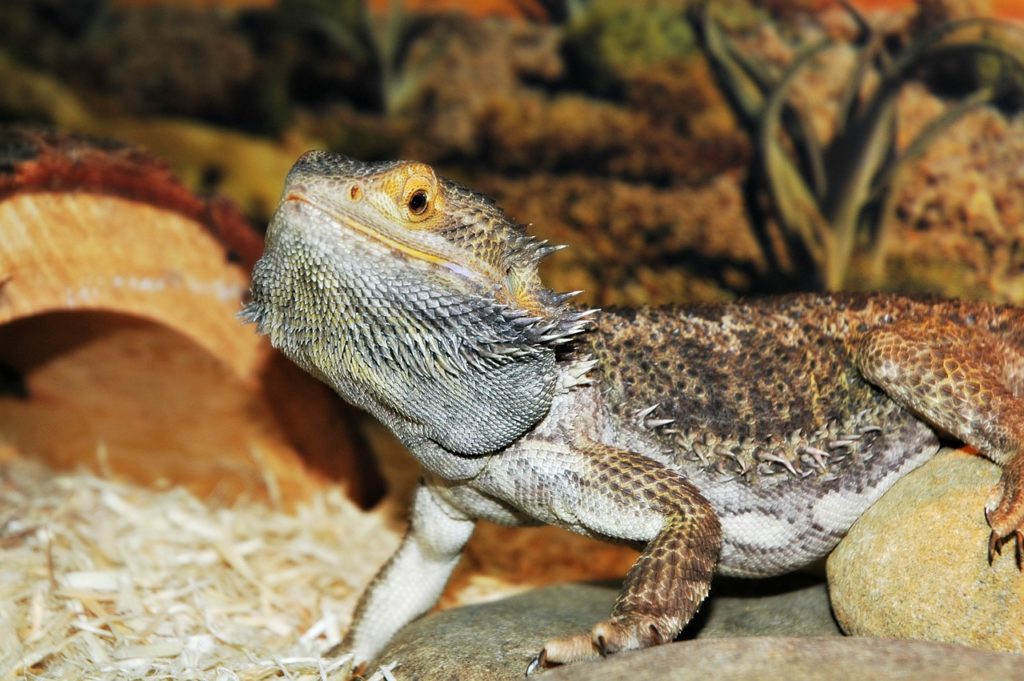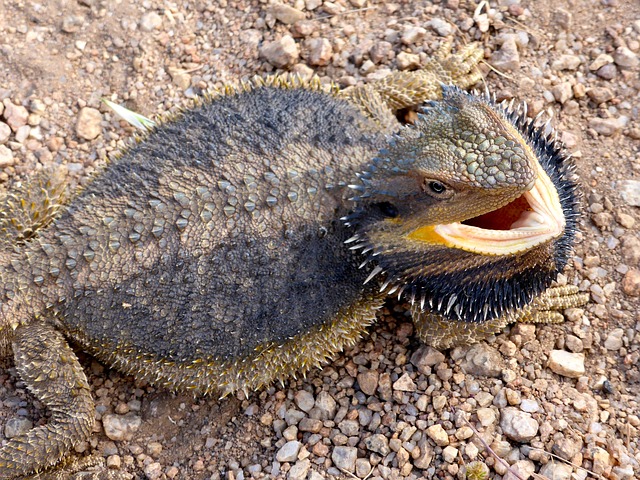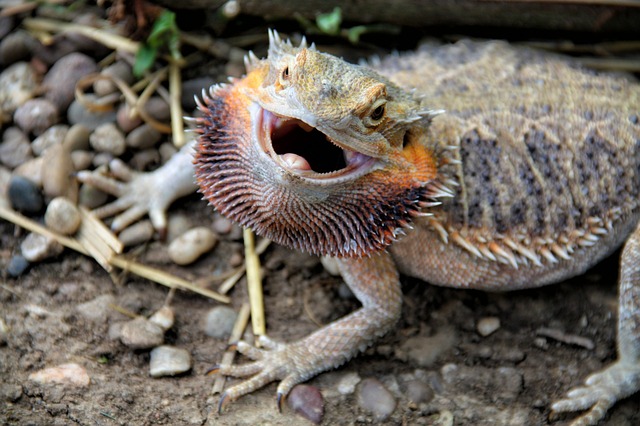If you have a pet bearded dragon, you likely already know a bit about their expressive personalities. When something is off with your bearded dragon, they are usually pretty good about letting you know.
With that in mind, when your pet is acting angry, it’s important to pay attention.

Beardies show anger in a number of ways, including trying to escape their enclosures, twitchy tails, fluffing their beards, and even biting.
Obviously, no one wants to be bitten by their pet, so realizing your bearded dragon is angry is the first step in determining how to fix the problem.
In this article, we discuss some of the more common signs of an angry bearded dragon so you can get started in helping them.
Quick Navigation
What to Do With an Angry Bearded Dragon
Bearded dragons are small critters with big personalities. Because of this, they make great pets and will often develop a rewarding bond with their owners.
However, they are also very expressive reptiles, and when dissatisfied will let their feelings known.
In this article we’ll be exploring what to do when you find yourself faced with an angry bearded dragon.
Symptoms of Anger/Stress in Bearded Dragons
Bearded dragons can be quite emotionally complex creatures, and anger can often be masking feelings of stress or fear, as the dragon has chosen a fight response over a flight response. General symptoms of an unhappy beardie include:
- Darker beard or color change
- Refusal to eat
- Reduction in motions/impaction
- Diarrhea
- Low activity levels
- Hard urates

There are also some more specified symptoms, which your dragon may or many not show, dependant on their needs or character.
Glass Surfing
This behaviour is often highly entertaining to bearded dragon owners, and can often been misinterpreted as one of the breed’s many quirks.
Glass surfing is where a bearded dragon moves back and forth its inclosure, as though trying to run up the glass sides.
This can actually be a sign of extreme stress or anxiety, as the beardie is trying to escape its tank, and is usually down to an enclosure that is insufficient or too small.
It could also be that it is feeling highly threatened by something else that is housed in the room. This behavior can result in injury, mostly due to chafing against the glass.
Tail Twitching
Like when a cat becomes irritated or is in the presence of prey, a bearded dragon’s tail can begin to twitch.
This may happen naturally, when they are being fed live prey, but can also happen during handling.
This is often a sign that the dragon doesn’t like the way you are holding them or are uncomfortable in your presence. If this is the case, then you may need to work on building up your relationship with your beardie further before proceeding with handling.
Fluffing their Beard
This is an outward sign of aggression/threatening behaviour, and could be down to an incorrect owner/pet relationship, as the beardie has deemed you a danger, and is warning you to back off. It could also be a sign of dominance if you have your beardies housed together.
Hissing
This is your beardie verbalizing their discomfort or distaste, and usually is a result of them feeling threatened.
Biting
This of course is a physical sign of aggression, and a sign that you beardie may not have bonded with you. It is important to keep handling your dragon, however, as this will encourage a bond to form. If your bearded dragon has bitten you, protect yourself using some gardening gloves.
Head Bobbing
In the wild, bearded dragons bob their heads to show dominance, and a beta male may bob their head as a way of challenging the current alpha. If your beardie is doing this to you, it could be that it deems you as a challenger. You should try to curb this behaviour by working on the bond between you and your bearded dragon.
What is Making My Bearded Dragon Angry?

There are many reasons why your bearded dragon might be showing you its dissatisfaction, and more often than not this anger is actually the manifestation of stress.
Bearded dragons are very sensitive to their surroundings, and an incorrect set-up or unexpected or disliked changes can put your beardie in quite the mood!
Below we have listed some of the most common reasons for beardie rage.
Poor Set-up
If this is your first time owning a beardie, or if you haven’t had your beardie for long, it is likely your dragon’s habitat is what it causing aggravation.
If the correct lighting, temperature, substrate, and scenery are lacking, then your beardie will probably end up feeling completely out of place, nervous, and stressed.
Remember, your bearded dragon’s home should be as close a replica to their natural habitat of Australia as possible.
If you are worried that this is why your dragon is angry, research some of the wild bearded dragon’s habitats, and adapt your set up to suit these.
For example, your beardie will need a place or places to hide.
This will allow them to mimic their natural survival instincts, burrowing away from predators or adverse weather, and to brumate safely.
We recommend either the Pangea Hide Box (if you want something affordable & don’t care about a natural look) or the Exo Terra Reptile Cave (if you don’t mind spending a bit more for looks).
Without necessary places to hide, your beardie will probably feel on edge, and therefore left in fight mode, result in a beardie that to their owner seems angry.
Check out our guide to setting up the perfect bearded dragon habitat if you suspect that your tank isn’t up to par!
Moving House or Habitat
As previously mentioned, bearded dragons are very sensitive to change, causing them to become stressed and angry.
The first time you will probably notice this behaviour is the first time you bring your beardie home.
This is perfectly natural, and is behaviour that, if the habitat is suitable and the care they recieve is good, this display of stress will pass in time. Depending on your dragon, it can take between a few days to up to a month for them to become comfortable in their new space.
The reason for this display of angry anxiety is because your beardie is feeling on edge, overwhelmed by new scents, sensations, and surroundings which they have to become acclimated to.
While of course having a new addition to your home is exciting, particularly if the beardie is to be a family pet, it is important not to crowd the tank in this adjustment period, as this can only increase the anxiety your new pet is feeling.
You are also likely to notice this behaviour if you and your beardie move house, or, if your beardie is particularly sensitive, if they move room, or even simply position in the room.
To reduce relocation stress in beardies until they acclimate, you should try to:
- Only handle your bearded dragon when necessary.
- Let the beardie get used to you. Place your hand in their tank palm up for several minutes at a time to show them you’re no threat.
- Let the beardie get used to your scent by placing an item of your clothing in their tank
- Reduce overstimulation, perhaps by covering the beardies habitat with a towel.
- Bathe them. A warm bath (85-92 F) will relax your beardie, as well as giving them a chance to clean and hydrate themselves.
- Offer food daily. Alongside their normal greens, offer food daily, even if they are disinterested. This will help the beardie to positively associate with you.
- Use a pleasant tone. Beardies have great hearing, and by speaking gently and slowly you’ll help to put them at ease. Speaking as you approach their tank will also prevent any risk of your sneaking up and scaring them.
Unwelcome Roomies
In the wild, beardies can be very solitary creatures and are very territorial. While it is possible for more experienced bearded dragon owners to have a few dragons in a tank together, this is usually exclusively two females and a male, and even then, the situation requires monitoring.
This is because in the wild bearded dragon groups run on a dominant/subordinate basis, with the alpha male or female getting the best basking spots, food, and general domination over the betas. Therefore, when two beardies are put together, particularly two males or two beardies of different age groups, it is likely one will start to bully the other, leaving the bullied party to become stressed and fail to thrive.
How to Calm an Angry Bearded Dragon
As previously mentioned in this article, bearded dragons are quite the characters, and therefore it may take some trial or error to figure out what is irking them. Below, we’ve compiled a list of some of the most common solutions, but you may find you need to turn detective to figure out just what your beardie is telling you!
Cramping their Style
Your bearded dragon may be feeling claustrophobic due to an enclosure which is too small or over filled with accessories. To cheer them up, ensure they have adequate time to roam around outside of their tank, try removing a plant or two, or best of all, invest in a larger tank.
Bad Vibrations
Bearded dragons are very sensitive to sound, and can use the smallest of vibrations to pinpoint a person’s movement.
While some loud noises can’t be helped, if someone in your family is prone to yelling, loud music, or turning the TV up, you may actually be causing your dragon some serious angst. Therefore, try to keep noises at a sociable level.
I’m boooooored!
Are you ensuring your bearded dragon’s life is enriched as possible?
If not, your beardie could be showing signs of anger because they are frustrated. Ensure they have activities and toys to play with, and, as they love to eat, you could even try feeding them some new treats. Just make sure they’re dragon-friendly first!
Rub-a-dub
As previously mentioned, bearded dragons love warm baths, and find them both relaxing and stimulating, as it offers a new environment for them to explore. It also allows them a chance to clean themselves, which will help improve their mood.
Finally, it’s a great chance for bonding with your dragon, often creating memorable moments to cherish.
Hold Me Close
Your beardie may display signs of anger if you are handling them incorrectly. Biting, hissing, or tail twitching can all indicate your beardie is trying to tell you it doesn’t like being handled that way, and that you should try a different approach.
You should also make sure your beardie knows you’re reaching in to pick them up, as alarm can trigger fight responses.
You should ensure that all of your beardie is supported when you hold them, and should keep up regular handling sessions to ensure you remain familiar to your beardie.
Problem Child
Your beardie might be displaying acts of anger or aggression simply because they have picked up bad habits.
While bearded dragons do not mimic the behaviour of others, and all their feelings are genuine, if a negative behaviour is deemed by the dragon to have been accepted or reinforced, it will repeat them.
For example, if your dragon bites you, reward it with a treat when it lets you go and opens its mouth. This will tell the dragon that not biting earns him food, thus reinforcing positive behaviour.
Feeling Hot
We all know our own tempers fray when the weather becomes uncomfortably hot, and it is no different for bearded dragons.
Though they live in the hot climate of Australia, if the temperatures become too hot in the tank for extended periods of time, and/or they do not have a suitable place to burrow, they could easily become short tempered.
Check that your heat lamps are set within the correct temperature range.
Hangry
Bearded dragons love to eat, and have quite a large appetite that stretches across a wide range of foods. It is important you ensure that your bearded dragon is being fed enough for their growth stage, or they could become angry simply because they are hungry.
You could also help to curb this by introducing some edible plants into their tank. This will allow your beardie to curb their hunger pangs, as well as encourage their natural foraging instincts.
Happy Again!
Hopefully this handy guide has helped you to curb your bearded dragon’s temper. Just remember that bearded dragons aren’t naturally angry creatures. They are generally quite happy and energetic reptiles, which is why they have grown so popular as family pets in recent years. When they become angry or stressed there’s almost always a cause, and it is your job as a great owner to turn detective and figure things out.
Of course, if the change in your bearded dragon’s behaviour is marked or extreme, or you are at a loss to the course, it is always best to err on the side of caution and seek the advice of a reptile specialist vet. It’s probably nothing serious, but ruling out medical concerns can often help put owners’ minds at ease, and if anything is noted, it ensures it is dealt with quickly, and with minimal additional stress to your beloved beardie.
Hello I have a bearded dragon and he’s extremely mean to me and my grandpa got me one when I was on vacation and he’s been really mean to me for a long time and I’ve been trying to pick him up and there’s no way to pick him up I’ve even used snow gloves to pick him up but it bit me and it still really hurt I have no clue what to do
Maybe you should try to take it slow and let it get used to you by keeping your hand in the tank and after it gets used to your scent,try stroking it inside the enclosure then build up from there
I have a beardie I adopted and he has been mean even when the other people had him. I’ve done everything and he is still mean.